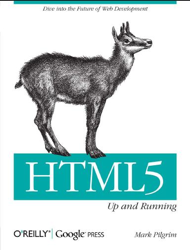 HTML5 Up and Running (US | UK) is one of the first books — if not the first — about HTML 5.
HTML5 Up and Running (US | UK) is one of the first books — if not the first — about HTML 5.
It's written by Mark Pilgrim, developer advocate for Google well know for its effort in the open source community and web standards. Mark is the author of several other publications including Dive Into Accessibility, Dive into Python, Dive Into Greasemonkey. Not surprisingly, his site is called Dive Into Mark.
The book provides a practical overview of the new features already available in HTML 5. HTML 5 is not a standard (yet), but browsers such as Safari, Firefox, Opera and Chrome already support many if its feature.
You may well ask: "How can I start using HTML5 if older browsers don't support it?" But the question itself is misleading. HTML5 is not one big thing; it is a collection of individual features. So you can't detect "HTML5 support," because that doesn't make any sense. But you can detect support for individual features, like canvas, video, or geolocation.
My two cents
I really enjoyed this book. I appreciated the HTML 5 introduction, the history of HTML and the tutorial about detecting HTML 5 features. But the chapter I enjoyed the most is the one about the new HTML 5 form inputs, probably because I have been able to start experimenting with them immediately.
As I already mentioned, the book is full of contextual hints and examples. This is really cool because examples help you to remember an information.
You don't need to trust me, you can check with your own eyes. Go for example to the Canvas chapter and see how well it is explained. I honestly can't imagine a better way to do this.
Audience
The book is very easy to read. It contains tons of examples, a very simple tone and several references. However, previous programming experience is recommended, especially if you plan to use advanced JavaScript-oriented features.
If you work with web interfaces, either as a programmer or designer, then you must read this book. However, this book is not a reference to start learning HTML. It assumes you already know about HTML, CSS and JavaScript.
Nevertheless, the How did we get there chapter is one of the best article I ever read about the history of HTML. And if you happened to migrate all your websites to XHTML (like the 90% of developers did) in the last 5 years, you might probably want to read the everything you know about xhtml is wrong paragraph — sigh.
Structure
HTML5 Up and Running is divided into an introduction, 11 chapters, and 2 appendix.
Here's the table of content:
- Introduction: Five Things You Should Know About HTML
- A Quite Biased History of HTML5
- Detecting HTML5 Features: It's Elementary, My Dear Watson
- What Does It All Mean?
- Let's Call It a Draw(ing Surface)
- Video in a Flash (Without That Other Thing)
- You Are Here (And So Is Everybody Else)
- A Place To Put Your Stuff
- Let's Take This Offline
- A Form of Madness
- "Distributed", "Extensibility", And Other Fancy Words
- Manipulating History for Fun & Profit
- The All-In-One Almost-Alphabetical No-Bullshit Guide to Detecting Everything
- HTML5 Peeks, Pokes and Pointers
The book is entirely available for free on the web at the Dive Into HTML 5 website.
Remember, JavaScript is the future
Since I mentioned JavaScript, let me take the time to highlight a very important concept: JavaScript is the future.
JavaScript stands to development like parsley stands to kitchen. You find it almost everywhere.
If you are a developer or designer, you can't continue to ignore JavaScript. And JavaScript appears to be even more important in HTML 5 because several features are designed to work with JavaScript. I'm talking about Geo Localization, Canvas and Local Storage, just to name a few.
So do yourself a favor: take the time to start learning and experimenting with JavaScript.